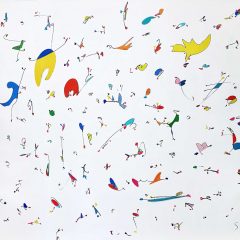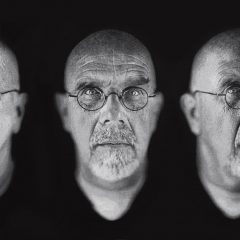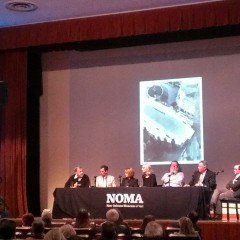As an 11 year old, Steven Rifkin received the most amazing gift. It wasn’t the Kodak Instamatic offered to him by his Uncle Abe from Johannesburg, nor the rolls of film that came with the camera. It began when Rifkin’s uncle took him for a walk through his suburban St. Paul, Minnesota neighborhood “to shoot pictures,” he said, “of whatever I was interested in.”
The idea that a square of roof, a sliver of eroded sidewalk or a bush on a small hill could open up vast worlds for a boy in America in the mid-1960s was far-fetched. But after the photographs were taken and then, a few days later, developed and printed at the local drugstore, Uncle Abe and Steven sat down to analyze the series of small, square black and white photographs.

Rifkin’s uncle seemed interested in the bush on the hill.
“He spoke about the space around the image, the sense of loneliness he felt looking at it,” Rifkin writes in a short text for his exhibition catalog “Untitled (Over Time).” The catalog accompanied a show of his black and white photographs at Les Douches La Galerie in Paris this winter (20 January – 3 March 2018).
Taken throughout the 1970s and 1980s, the photographs, small and square, each echoes the quiet thrill of those first Instamatic images.
That day in 1966, the two discussed the lines of the roof shingles, how they intersected, the geometries of the objects and how they sat in their space, and that strange thing “negative space.” Rifkin said he then understood that these photographs revealed what the mind’s eye actually saw.
“This was the first time that an adult treated me like a peer,” Rifkin wrote. “It made a powerful impact for a very young person.” It was this exchange, said Rifkin, that turned out to be the gift of a lifetime.
The Wild Midwest
Steven Rifkin came of age aesthetically in the 1970s, weaned on the art house photography of that time and before. He attended the Kansas City Art institute to obtain his BFA and received his MFA from Indiana University. Walker Evans, Tony Ray Jones and Henry Holmes Smith figure high up on Rifkin’s list of influences. Others like Peter Beard, Victor Skrebneski, Robert Mapplethorpe bring a lot to his table too. As for that first Instamatic, Rifkin has since moved on; he used 2¼ x 2¼ – inch format Rolleicord, Rolleiflex and Hasselblad cameras for the Paris show.

Rifkin’s small black and white photographs are intimate windows onto his world that expand subtly upon his first experiments with the camera. Each “Untitled,” save for the addendum of place and date, they are chance encounters in America’s midwest that bear a kind of metaphorical witness to some small crisis, the moments-after of a crime scene, an elegant, unsolved mystery.
A second and third look at the garage door that came down on the trunk hood of a Chevrolet in Kansas City, Missouri (1975) for example, is both funny and obtuse. But it is also a perfectly composed study of space — rectangles, boxes of white and grey. What pulls Rifkin to this “accident” seems to be a fascination with man-made geometry and narrative, even folly.
The same is true for his photograph of three concrete culverts angled up towards the sky along a grass road in Unionville, Indiana (1977). These smooth cylindrical objects, aligned diagonally, define the composition with circles and lines. They could be beacons abandoned on earth open to the vast universe, or young birds’ maws open for a feeding. They absolutely have a purpose, but it’s a mystery. Rifkin, I realize, serves as a guide to the randomness of things.
Industrial forms and everyday folks
One of my favorite series of images is of a snow-blanketed Lake Lemon from Unionville, Indiana (1977). At first I have no idea what I am looking at but I know it’s terribly beautiful, quiet and strange — a photograph of the cold, dry wind baked in sunlight. We see a deep layer of snow covering some odd structures; tires seem to be attached to them, poles poke out of the ground and bits of metal swim in a long ago winter pool of whiteness. Then it occurs to me — this is a lake — and these are boat docks.
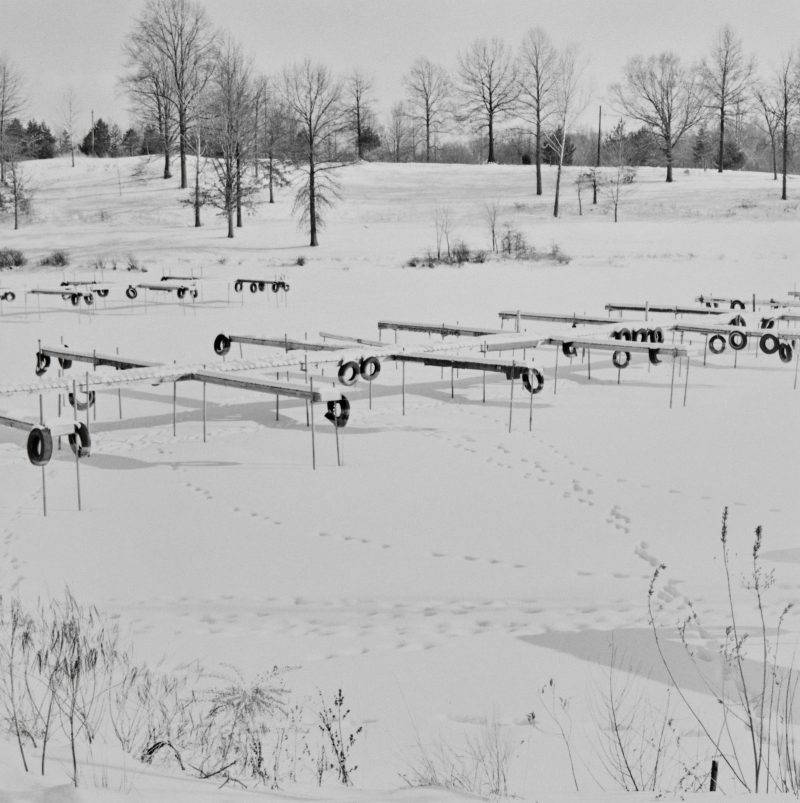
While Rifkin loves the abstract qualities of large industrial objects — sides of trucks, metal culverts and a roof overlooking a farm yard — he occasionally captures a candid crowd scene framed by public or industrial architecture. His heroes are a kid on a tricycle or men painting houses, emptying crates of Coke, and washing windows.
His butcher working a side of beef in a slaughterhouse in South St. Paul, Minnesota (1976) offers a fresh feel to an image we already know. It’s brutal, common, workaday — a muscular poetry of late post-war America. Astonishing, too, is a full on portrait of man who has lost his legs; he holds his bundle of newspapers and smiles as he poses on a sidewalk in Kansas City, Missouri (1976). There is warmth and sympathy here, but something else — an aching sadness — and Rifkin doesn’t flinch to capture it.
Looking closer
Lastly in “Untitled,” there are a number of large-format black and white prints; they maintain the square format (55 x 55 inches) and radiate a glow of sepia tone. At first glance they seems unknowable, mysterious.
I put my nose to the glass on one large work, taken in 1995 (edition of three), only to discover several thousand monarch butterflies all hugging a tree, knitted together wing over wing like an intricate afghan. I imagined they are resting there perhaps before migration to northern geographies from their birth place in Michoacán, Mexico. And it isn’t hard to imagine Rifkin approaching stealthily, as I did, to understand this natural miracle and capture its geometry.
There are so many monarchs, so densely packed, that from a distance they could be ordinary leaves or rocks, or a dark graphite drawing of a canyon wall. But as you draw near you can almost hear their wings shiver. Rifkin insists again that immersion is key to understanding.
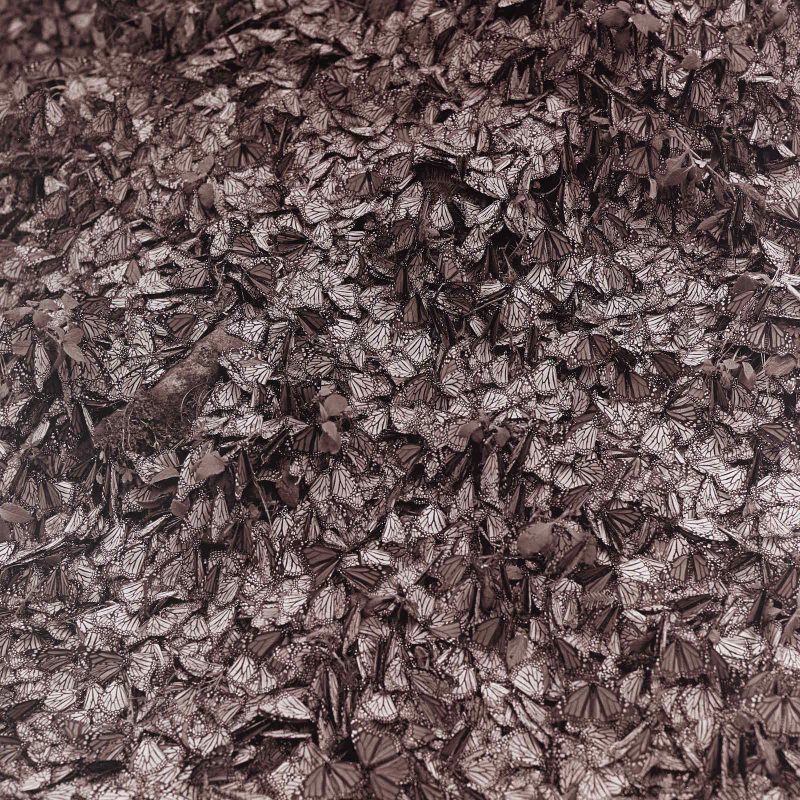
Addendum: Steve Rifkin also works as a printer in Mount Vernon, New York Hanks Photo, with a long list of client photographers such as Lynn Davis, Larry Clark, Tseng Kwong Chi, Adam Fuss, Timothy Greenfield-Sanders and Diana Michener. Some catalogs of Untitled (Over Time), (76 pages; 2018) are available through Rifkin directly: steve@hanksphoto.com or by sending written requests to 25 Elm Avenue, Mount Vernon, NY 10550, United States.



